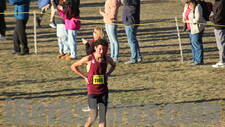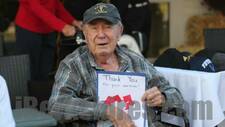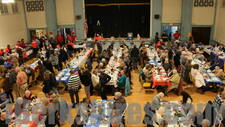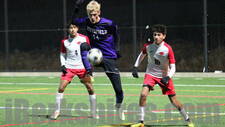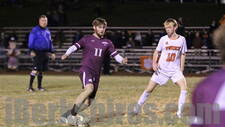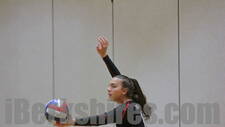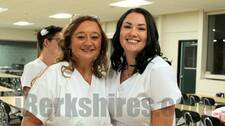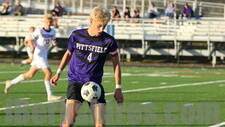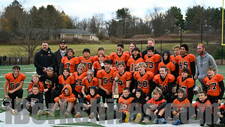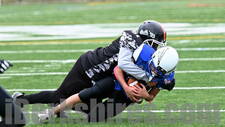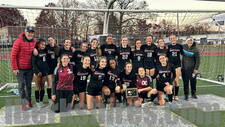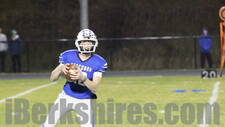Bytes from the Bean by Joe Manning 6-1-0012:00AM / Thursday, June 01, 2000
"Four weeks into my job (January 1991), we got a fax from Governor Weld. Joe and Jennifer were out of town. It basically said that MASS MoCA was finished, and we could pack our bags. I was really scared. I was sure that I could find another job, so I wasn't worried about that. I just kenw that MASS MoCA was going to help save my hometown, and I wanted Joe and Jennifer to succeed, because they were fighting so hard for it.
Some days were mighty depressing. So many people were predicting our doom. Things were so bad, that we went without a paycheck for a few months once. When the funding finally came, we got paid back, but it was tough. For a while, we worked part time and got part-time pay. People would ask me, 'How can you do that? It's not a volunteer job.' I had some money saved, and I was determined to stick it out as long as Joe and Jennifer did.
When we had the private reception for members on the Friday of the grand opening weekend in 1999, there was a sense of relief. We had worked around the clock including weekends for about two months preparing for it. It was so much work. We weren't just getting the museum ready, we also had all those events we planned.
When the huge crowds came that weekend, it was unbelievable. We were so excited. But on Monday, I think we didn't really believe that people would actually continue to come. We were so used to seeing the place off limits to visitors, that when people came through the courtyard, we almost stopped them and said we weren't open. It took a few weeks for it to sink in that we had a museum that was open every day. It had been a project for so long.
I miss those buckling floors now. I miss the rooms with no heat and no art. I was always going in those buildings to look for Joe or Jennifer. I would go in on my own at least once a week, just to see what was new. There's a longing for those old days."
-Paulette Wein, from the forthcoming book Disappearing Into North Adams
I understand what Paulette means. I watched the MASS MoCA project with great interest and anticipation for nearly three years. I went on nearly a dozen hard-hat tours and was the recipient of several private one-on-one tours while conducting interviews there for my new book. I found the site so eerie and beautiful, that I would often just walk over and stare at it. I always had my camera ready for a different sun, a different sky, and a new angle.
After the clock tower sound sculpture was completed, I got in the habit of going over there every evening just before the end of my weekly visit and sitting on a picnic table in the main courtyard, just so I could listen to the bells.
Two months before MASS MoCA opened on Memorial Day weekend, before the art was installed, I got permission to walk through the empty gallery spaces and take some pictures. For most of the two hours I spent in those buildings, there was no one there but me. It was an experience that I will never forget.
When I left, I was sad. I knew it was the last time I would ever see it that way again. On grand opening day, I struggled in with the crowd after the ceremony, but there were just too many people. I hung around to listen to a few comments and then went home. As I left through the main gate, I turned around and said out loud, "It belongs to everyone now."
As I write this, MASS MoCA is preparing for its new season. It's already a year old and not a strange idea that somebody is talking about. In twelve short months, MASS MoCA has resulted in one good thing after another. First-year attendance was nearly 100,000. There were numerous articles in national publications such as the New York Times, the Wall Street Journal, the Boston Globe, and Smithsonian Magazine.
The rental space in Building One brought in a host of E-commerce businesses, among them a new major player called eZiba. Other businesses are waiting in line for the next renovated spaces. This has attracted a huge amount of venture capital, ironically coming out of Williamstown, that reflects growing confidence in North Adams. We've got seventy PRG employees moving into the Roberts Building, and I see many of these dot.com folks on Main Street every morning. "Tunnel City" is now "Silicon Village."
And how about River Street! Would anybody have ever thought that the Red Lion Inn folks would be naming a satellite inn after River Street? This is a marvelous project that will not only bring in the Red Lion customers in South County, but will also set a standard for future redevelopment: renovation, not demolition.
Still, I'm like most of us on summer weekends. "Where are all these visitors they are talking about? Main Street still looks the same to me. Why aren't they down here?" Well, think about it. Suppose you got a job over at MoCA directing visitors to the rest of the city. What would you direct them to? Imagine this conversation:
"Don't forget to visit our beautiful city. Main Street is just two blocks away."
"Sure, we're staying over in Williamstown for a couple of days. We've got some time. What do you suggest?"
"Uh."
There are plenty of things to see and do in North Adams. The problem with many of us is that we don't think anyone will be interested. After all, it's home, not Disneyland. It's not where we go on vacation. But if we feel that way and show it, why will visitors have any reason to believe that North Adams has anything to offer?
North Adams seems to lack a clear identity, at least one we are willing to brag about. We have never been comfortable with its image. It's a mill town, not Stockbridge or Lenox. When Sprague left and we were no longer a mill town, we couldn't define ourselves any longer.
What does North Adams have to attract MoCA visitors, many of whom are well-educated and intellectually curious? To these people, there is a lot more that should be pointed out besides a few restaurants and retail stores. After they eat or buy film, they will still run for the exits. We must tell them and show them what North Adams was and is all about. We must give North Adams a real identity that is interesting and reflects our pride in the city; not just for what it was, but for what it is now.
We need to show visitors our history and our beauty. I don't mean just a visit to the Historical Society Museum, even though it is a marvelous place to see; or the Hoosac Tunnel Museum at Heritage Park, which is a great place to take the kids. Those are obvious.
Many cities and towns provide self-guided walking tours. The Historical Society has several excellent guides. We need to donate our money and time, so they can create additional guides and make all of them available in stores and restaurants as well as at MASS MoCA. With enough public support, including volunteers, we should also be able to provide tour guides on weekends. If we can do this, the question becomes, "What do we tell them, and what do we show them?"
1. We show them the architecture on Main Street, Eagle Street, Church Street, North Church Street, and other areas near downtown. In fact, we should put up markers on every historic building downtown (like the ones on Church Street), markers that indicate date built and other information. If we don't do that, visitors will assume that our architecture is ordinary and of no interest.
2. We tell them about urban renewal: what was standing in the renewal area before demolition, and how it changed the character of downtown. If we don't, visitors will assume there was nothing on the south side to begin with.
3. We tell them about our ethnic neighborhoods: Little Italy on State, Furnace and Walnut Streets and the large houses that are there; the Lebanese area on lower State Street; the French-Canadian neighborhood near the Union Street mills; and the Jewish neighborhood on Ashland and Spring Streets and Washington Avenue. If we don't, visitors will assume we have no identifiable ethnic character or any historic neighborhoods.
4. We tell them about the various shoe mills and cotton mills, and show them what we have done to reinvigorate those mills, especially the Windsor Mill and Eric Rudd's Beaver Mill. If we don't, visitors will assume that MASS MoCA is the only former mill we care about.
5. We point out and explain the flood control chutes and talk about the floods we used to have and how the river used to look. If we don't, visitors will assume that the river means nothing to us.
6. We show them the Mohawk Theatre and our plans for restoring it. If we don't, visitors will assume we are just letting it fade away.
7. We show them Hillside and Southview Cemeteries, Natural Bridge, and MCLA. If we don't, visitors won't even know they are there.
8. We show them the ragged beauty of our old neighborhoods on River Street, Bracewell Avenue, North Holden Street, Francis Street, and Hall Street; and the quiet and still sparkling neighborhoods on North Street, Cherry Street, and Marion Avenue. If we don't, visitors will assume that we take no pride in our neighborhoods.
9. We show them the library and the churches and talk about their history. If we don't, visitors will assume there is nothing notable about them.
North Adams doesn't really lack a clear identity. We just haven't accepted it yet. We're an old city. We are what we are, and we should be proud of it, even the wrinkles. Tourists have plenty of postcard Berkshire towns to see, and they've seen them year after year. Like everyone, when we go on vacation, we want to see something different. If we take the time to show visitors who we are, they will take the time to look. And they will talk about North Adams when they eat at our restaurants; and when they buy film, they will take photographs of our beautiful city and show them to their friends.
Do you remember the mystery photo in my April 1st column? If not, click on that column and check it out. Here are the best responses I got.
"My guess is that this photo was taken in the general area of the hospital, where the two roads run up toward Clarksburg."
-Mark Rondeau (Wrong! Sorry Mark)
"I can't identify the mystery photo, but knowing North Adams, it could be in any of a hundred locations. First place I would check is on the west end of River Street, an area known back in the forties as Burdickville. At that time, all the Burdicks lived out in that area.
-Bill Hodgson (Wrong! Sorry Bill)
"In the mystery photo in your most recent column, the roof on the left side, the cone shape, makes me think of an area where some friends lived, possibly Prospect or Wesleyan Streets, which are north and east of River Street, if my memory serves me right. Wesleyan Street is a hilly area."
-Charlie Hoye (CLOSE! Nice going Charlie)
"I live in north Adams, and I believe that I have figured out the location of the photo. I was able to see pretty much the same view by standing on Hall Street, near where Grove Street connects to it, looking towards Eagle Street. I'm not sure if that is where you took the picture from (you mentioned you used a zoom lens), but this location gave me pretty much the same view."
-Mario Catelotti (RIGHT!!! You got it Mario)
Speaking of mystery photos, I hope you have seen my newest addition to NorthAdams.com: "Joe Manning's Mystery Photo Contest." It's up on the homepage about once a month. The first person to correctly identify the photo wins a free lunch at The Bean and a free NorthAdams.com T-shirt. WATCH FOR IT!
Visit Joe's website at: www.sevensteeples.com.
Email Joe at: manningfamily@rcn.com
|


